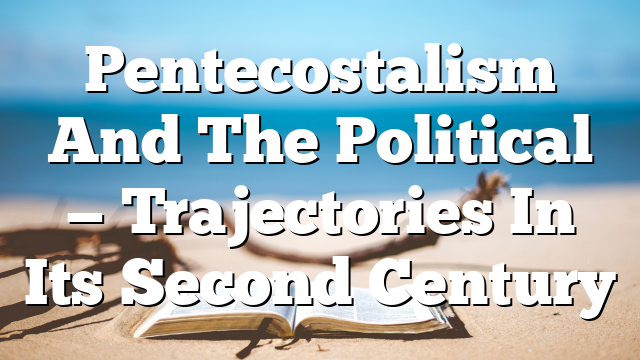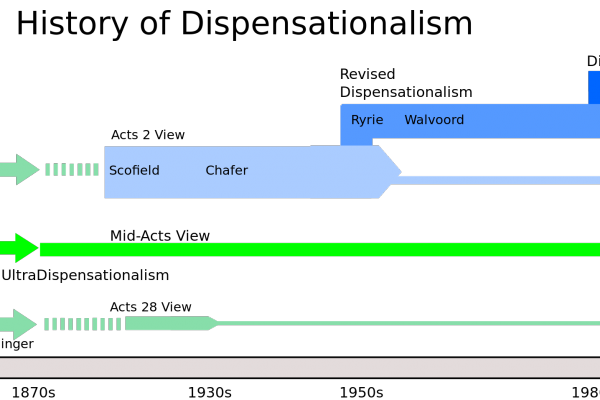Click to join the conversation with over 500,000 Pentecostal believers and scholars
Click to get our FREE MOBILE APP and stay connected
| PentecostalTheology.com



Pneuma 32 (2010) 333-336
Pentecostalism and the Political — Trajectories in Its
Second Century
Amos Yong
Modern Pentecostalism has long been stereotyped as being politically quies- cent. Tere are a number of reasons for this persisting label, almost all of which are tied into an overall otherworldly spirituality informed by what Ste- ven Land has called “a passion for the kingdom.”1 In terms of its piety, the focus within the movement worldwide has been, generally speaking, on Jesus as the soon-coming king, and thus on the future reign of God. Underneath this hope for a better world has been a dispensationally construed theological system, one by and large uncritically borrowed from the conservative evan- gelical prophecy movement of the late nineteenth century, that laid emphasis not on the possibilities for the transformation of this world but on its increas- ing wickedness and apocalyptic nature instead. Pentecostals have thus com- mitted themselves not to political processes but to evangelism, missions, and soul-saving — activities designed to prepare the inner hearts of their fellow humanity for the great and glorious day of the Lord.2
Within this eschatological framework, it’s not that Pentecostals have been strangers to the political domain altogether, but that this has more frequently denoted internal ecclesiastical disputes instead. Tus, with any reference to “Pentecostal politics,” most would think about the kinds of processes that Harold Hunter describes in his article in this issue of the journal on develop- ments among leaders in the early Church of God regarding its organization. Historically, of course, the paradigm for “charismatic politics” may have been set in the early church initially by the congregation at Corinth but then later by the movement that Cecil Robeck discusses in his review essay on the work
1
Steven J. Land, Pentecostal Spirituality: A Passion for the Kingdom, Journal of Pentecostal Teology Supplemental series 1 (Sheffield: Sheffield Academic Press, 1993).
2
See also D. William Faupel, Te Everlasting Gospel: Te Significance of Eschatology in the Development of Pentecostal Tought, Journal of Pentecostal Teology Supplemental series 10 (Shef- field: Sheffield Academic Press, 1996).
© Koninklijke Brill NV, Leiden, 2010 DOI: 10.1163/157007410X531880
1
334
A. Yong / Pneuma 32 (2010) 333-336
of William Tabbernee, the premier scholar of Montanism. Te Montanists were charismatic Christians who not only affirmed the prophetic ministry of women against the male clericalization of the church of its time, but they also opposed the moral laxity of the ecclesial hierarchy in accordance with their eschatological expectation that Christ would soon return for a pure and sancti- fied bride. Tese were the kinds of political challenges that led to the church’s rejection of the fledgling Montanist movement, a rejection that involved pro- nounced judgments regarding the so-called heterodoxy of its teachings and practices. Te politics of renewal movements throughout the ages since have been marked by such a dynamic: a challenge is issued to the ecclesial center from the periphery in an effort to restore essential aspects of the church’s iden- tity and mission, followed by formal denunciations that both marginalized such movements and effectively declared them to be illegitimate options for the faithful.
To be sure, while the preceding contains elements of truth regarding the bifurcation in Pentecostal circles between their spirituality and piety on the one hand and the public arena of the political on the other, contemporary research on Pentecostalism and work in the emerging field of political theol- ogy are combining to paint a rather different picture. At one level, Pentecostal- ism is not as bereft of political engagement as the standard account has portrayed; at another level, we are also coming to realize that the come-outism characteristic of Pentecostal movements involved an ecclesial sectarianism that could be understood as reflecting a posture vis-à-vis the public square with substantive political consequences. Te rest of the articles in this issue of Pneuma expand our horizons in thinking about Pentecostalism and the politi- cal precisely in both of these directions.
For instance, Joel Halldorf’s discussion of the life and work of Swedish Pentecostal church leader, Lewi Pethrus, highlights his explicit commitments, informed by his Pentecostal spirituality, to shaping Swedish society. Pethrus did so not only by establishing a political party but also by engaging in a wide ranging set of institution-building activities. His doing so both provides a template for other Pentecostals who feel the call to make a difference in the sociopolitical arena and invite more research that will bring to the surface the work of other Pentecostals who were politically involved but about whom we know little or nothing.
By contrast, Steve Offutt’s discussion of transnational Pentecostal mega- churches in Guatemala and South Africa reflects the political influence wielded by the movement. If we were looking only to identify explicit forms of this- worldly activity, we might think that Offutt’s ethnographic work confirms the
2
A. Yong / Pneuma 32 (2010) 333-336
335
traditional stereotype about an apolitical Pentecostalism concerned more about spiritual salvation than about the public square. Yet astute political observers and even politicians recognize the important role that Pentecostal megachurches play in their communities and even their countries. Tese are centers of networks which could potentially mobilize the masses, even if only indirectly, to support certain political causes or candidates and thus should not be ignored or overlooked by those engaged with the political process. In other words, even Pentecostals who are not intentionally occupied in the public square are political presences and actors.
Political theologians have recently begun to appreciate how the church as the people of God embodies a set of political sensibilities and commitments even when not directly working in the polis. Tus Stanley Hauerwas’s (and William Willimon’s) notion of the “resident alien” nature of the church already indicates how there is a counter-cultural and even a counter-political identity with and through which the church relates to the world while John Howard Yoder’s emphasis on the anti-Constantinian character of the people of God even more explicitly suggests how the body of Christ works for social transfor- mation not necessarily through direct political action but by faithfully doing the works of Christ and persistently seeking the peace — i.e., praying for — their communities, cities, and nations.3 In short, these approaches accentuate the apostolic admonition to live quiet and peaceful lives amidst the public square and may shed new theological perspective on historic Pentecostal sen- sibilities. More to the point, to the degree that Pentecostals have occupied the underside of history, or operated on the margins rather than at the center of the polis, to the same degree they have instinctively followed in the footsteps of the earliest messianic followers who shunned explicit political activity aside from ensuring the preservation of their rights as citizens of the Pax Romana to bear witness to the gospel. But living quiet and peaceful lives does not neces- sarily mean being politically absent; it could set the stage for a counter-cultural way of life that is politically subversive.
But what if Pentecostals have climbed the ladder of upward mobility and are no longer only on the margins of society? If that is indeed the case, at least with certain segments of the global renewal movement, then perhaps other political postures and practices are warranted. Estrelda Alexander’s presidential
3
E.g., Stanley Hauerwas and William H. Willimon, Resident Aliens: Life in the Christian Colony (Nashville: Abingdon, 1989); and John Howard Yoder, Te Priestly Kingdom: Social Ethics as Gospel (Notre Dame, Ind.: University of Notre Dame Press, 1984), idem., Te Jewish-Chris- tian Schism Revisited, eds. Michael G. Cartwright and Peter Ochs (Grand Rapids and Cam- bridge, UK: Eerdmans, 2003), and many other books.
3
336
A. Yong / Pneuma 32 (2010) 333-336
address to the Society of Pentecostal Theology in March 2010, published in this issue, presents one model of a prophetic Pentecostal political approach, one informed by a long tradition of African American Pentecostal interactions with the public domain. If Pentecostals claim to be filled with the Spirit of the living God who also emboldened the prophetic witness of the ancient Israelite and Hebrew seers, then perhaps one manifestation of such Spirit-empowered lives would be a righteous protest against the various -isms that perpetuate injustice in the world.
I am convinced that the second century of modern Pentecostalism will unveil both a more politically subversive renewal movement and also a more explicit politically engaged set of charismatic beliefs and practices.4 Te articles in this issue of the journal reflect only a few aspects of the dynamism behind Pentecostalism and its interface with the political. Much more research needs to be done; may readers take heart and get about the important work at this turbulent intersection.
4
My In the Days of Caesar: Pentecostalism and Political Teology (Grand Rapids and Cam- bridge, UK: Eerdmans, 2010), documents just such developments while also proposing a con- structive political theology in light of Pentecostal histories, concerns, and perspectives.
4




Most Talked About Today